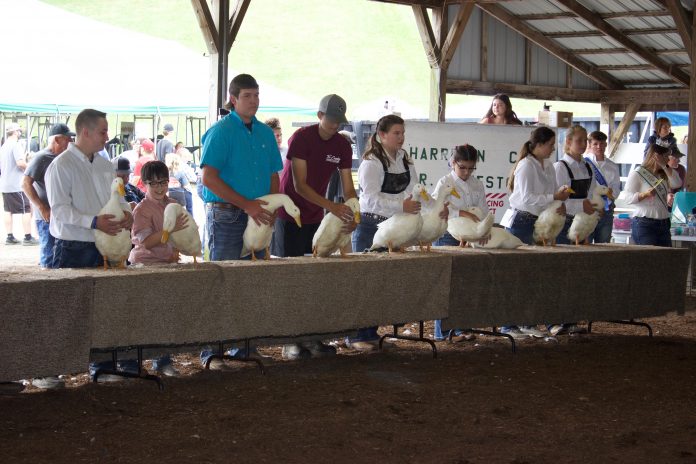Ohio 4-H extension educators see two trends with 4-H’ers this year. Some are taking a year off or otherwise stepping back from the program, largely due to concerns about the pandemic. Others are doubling down.
The 2020 fair season was full of uncertainties. Fair and 4-H guidelines and plans changed several times throughout the year. Heading into 2021, some wondered if 4-H enrollment numbers would be down.
In Columbiana County, enrollment was just about 50 shy of pre-pandemic numbers, after the March 1 deadline. In 2020, about 680 4-H’ers enrolled in the county.
Audrey Dimmerling, 4-H youth development director for Columbiana County, was encouraged to see numbers stay similar to last year, despite the uncertainties. She is planning a meeting with 4-H volunteers March 9 to talk about ways to keep it a positive experience and work with both in person and virtual programs.
“We can expect a drop in numbers this year,” she said. “We just want to keep everybody informed, give them tools to encourage them to meet on a regular basis … even when it might look a little different again this year.”
4-H leaders are continuing to work out details of the 2021 season, as enrollment deadlines for other counties approach.
“This is such a challenging time for not just 4-H, but for all organizations,” said David Crawford, 4-H youth development educator for Stark County. “I understand families not being all in at this time. We do have a lot that are, and we have some that are on the fence.”
Enrollment
Crawford is expecting to see lower numbers in his county, though it’s hard to tell since many seem to be making decisions later than usual, as they look at different safety restrictions and guidelines and try to anticipate what could happen for 2021.
“We’re planning for in person activities, knowing that we may need to pivot or make a change,” Crawford said.
Last year, nearly 64,000 youth participated in 4-H through local clubs, down about 4,600 from 2019, Jacqueline Wilkins, associate dean of Ohio State University Extension, told the Ohio House agriculture committee, in a Feb. 23 informal hearing.
Hannah Epley, interim associate state 4-H leader, told Farm and Dairy it’s hard to predict statewide enrollment numbers until later in the year, since some counties have later deadlines and many 4-H’ers register at the last minute.
In other counties, like Mahoning County, things seem to be on track with where they usually would be at this point. Mahoning and Stark counties both have enrollment deadlines coming up March 15.
“Most of the enrollments come in the last week,” said Beth Smith, Mahoning County 4-H youth development educator.
Across the state, Smith said, many have been expecting enrollment to be down a bit, but it isn’t looking that way in her county so far.
“I think it’s really just because of the involvement of the committees and 4-H advisers,” she said. Committee members and advisers have been reaching out to 4-H’ers and holding meetings, even when they have to be virtual, to keep them engaged.
Katrina Nitz, 4-H youth development educator for Carroll County, said enrollment in her county also seems to be holding steady. They’ve tagged in 117 market beef projects, which is close to typical.
“People, if they’re going to do 4-H, they’re going to do 4-H and are not backing down,” Nitz said.
Projects
Stark and Mahoning counties have also seen close to normal numbers on beef projects, one of the market projects that kicks off earliest in the year. 4-H’ers in many counties get their beef project animals the November before the upcoming fair.
Tom Turner, of Turner Shorthorns, who sells show calves to 4-H’ers for beef projects, said he didn’t see much of a difference from a typical year last fall when 4-H’ers in his area started looking for calves for 2021 beef projects.
“I think last fall, people thought by this summer, we would be out of [the pandemic],” Turner said.
Danny Ahrens, of Ahrens Show Pigs, in Ravenna, said the farm downsized the number of pigs it bred and raised for 2021, due to concerns about how the pandemic would affect things this year. He also saw a lot of pig farmers selling bred female pigs last fall.
But while a few families he normally sells to have dropped out of showing for this year, the ones that have stayed aren’t necessarily relying on the county fairs to have shows — they’re also looking at other options, like jackpot shows. And even last year, he added, most fairs in his area had some type of show and sale for 4-H’ers.
Camp
4-H camps took a hard hit in 2020, with only about 800 campers joining virtually, Wilkins said. That’s a stark difference from the 12,079 campers that participated in 2019. While that contributed to financial challenges for camps, Wilkins said camps have been able to survive so far through donations and cost-saving measures.
4-H extension educators are continuing to plan for 2021 camps, but won’t get official guidelines and decisions from Ohio State University Extension until April 1. Smith and Dimmerling said their counties have already chosen counselors and started planning for the summer.
“We’re hoping for a regular, full camp, but we’re prepared either way, if we have to modify,” Dimmerling said.
Nitz is hoping for an overnight camp, but also working on back up plans.
“We’re pushing through as if it’s a regular year, but also having plan B’s and plan C’s on every program,” she said.
Long term
It’s hard to say what the long term impacts of the pandemic will be yet. Smith, Dimmerling and Nitz all said they think it will be easier to get enrollment back up once the pandemic is in the rearview.
“I think communication is going to be key,” Dimmerling said. “I think numbers will increase again, once … they feel that we can go back to traditional programming.”










